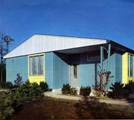
Lustron Homes (1948 – 1950s)
Made of steel coated with porcelain enamel, Lustron Homes were manufactured like cars and transported across the USA.
History:
At the end of World War II, the United States didn’t have enough housing for the 12-million soldiers returning home. President Harry Truman pressured builders and suppliers to construct affordable housing. One of the most promising ventures was the Lustron Home by businessman and inventor Carl Strandlund. Vowing to mass-produce steel houses at the rate of 100 a day, Strandlund landed $37 million in government loans.
The first Lustron house was produced in March 1948. Over the next two years, 2,498 Lustron Homes were manufactured. The steel houses were made like cars on conveyor belts. Flatbed trucks transported the Lustron panels to 36 states, where they were assembled on concrete slabs. Assembly took about two weeks. The completed house cost about $10,000, not including foundations and the lot.
Orders for some 20,000 Lustron Homes poured in, but by 1950 the Lustron Corporation was bankrupt. Today, well-preserved Lustron homes are scarce. Many have been demolished. Others have been altered as homeowners added drywall walls and new exterior siding.
Features:
One-story with a rectangular Ranch Style shape
Roof and walls made of prefabricated steel panels
Panels coated with colored porcelain enamel (the same finish found on bathtubs and appliances)
Four factory-colored finishes: Desert Tan, Dove Gray, Maize Yellow, or Surf Blue
Magnets or glued-on hooks used to hang pictures on metal walls
Concrete slab foundation
Two or three bedrooms
Radiant heating in the ceiling
Built-in bookcase, china cabinet, and overhead cabinets
Combination washing machine / dishwasher
Next: Eichler Houses